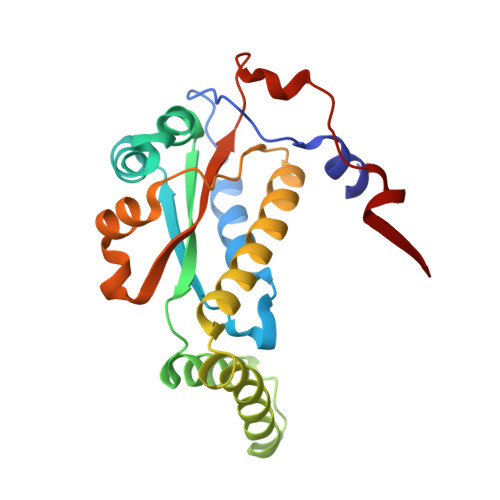Studies on the Nitroreductase Prodrug-Activating System. Crystal Structures of Complexes with the Inhibitor Dicoumarol and Dinitrobenzamide Prodrugs and of the Enzyme Active Form.
Johansson, E., Parkinson, G.N., Denny, W.A., Neidle, S.(2003) J Med Chem 46: 4009-4020
- PubMed: 12954054
- DOI: https://doi.org/10.1021/jm030843b
- Primary Citation of Related Structures:
1IDT, 1OO5, 1OO6, 1OON, 1OOQ - PubMed Abstract:
The E. coli nitroreductase enzyme (NTR) has been widely used in suicide gene therapy (GDEPT and ADEPT) applications as a activating enzyme for nitroaromatic prodrugs of the dinitrobenzamide class. NTR has been previously shown to be a homodimeric enzyme with two active sites. We present here the crystal structures of the reduced form of NTR and its complexes with the inhibitor dicoumarol and three dinitrobenzamide prodrugs. Comparison of the structures of the oxidized and reduced forms of the native enzyme shows that the principal structural changes occur in the FMN cofactor and indicate that the enzyme itself is a relatively rigid structure that primarily provides a rigid structural framework on which hydride transfer occurs. The aziridinyldinitrobenzamide prodrug CB 1954 binds in nonidentical ways in both of the two active sites of the homodimeric enzyme, employing both hydrophobic and (in active site B) a direct H-bond contact to the side chain of Lys14. In active site A the 2-nitro group stacks above the FMN, and in active site B the 4-nitro group does, explaining why reduction of either nitro group is observed. In contrast, the larger mustard group of the dinitrobenzamide mustard compound SN 23862 forces the prodrug to bind at both active sites with only the 2-nitro group able to participate in hydride transfer from the FMN, explaining why only the 2-hydroxylamine reduction product is observed. In each site, the nitro groups of the prodrug make direct H-bond contacts with the enzyme; in active Site A the 2-nitro to Ser40 and the 4-nitro to Asn71, while in active Site B the 2-nitro contacts the main chain nitrogen of Thr41 and the 4-nitro group the Lys14 side chain. The related amide-substituted mustard SN 27217 binds in a broadly similar fashion, but with the larger amide group substituent able to reach and contact the side chain of Arg107, further restricting the prodrug conformations in the binding site. The inhibitor dicoumarol appears to bind primarily by pi-stacking interactions and hydrophobic contacts, with no conformational changes in the enzyme. One of the hydroxycoumarin subunits stacks above the plane of the FMN via pi-overlap with the isoalloxazine ring, penetrating deep into the groove, with the other less well-defined. These studies suggest guidelines for further prodrug design. Steric bulk (e.g., mustard rather than aziridine) on the ring can limit the possible binding orientations, and the reducible nitro group must be located para to the mustard. Substitution on the carboxamide side chain still allows the prodrugs to bind, but also limits their orientation in the binding site. Finally, modulating substrate specificity by alteration of the structure of the enzyme rather than the prodrug might usefully focus on modifying the Phe124 residue and those surrounding it.
- Cancer Research UK Biomolecular Structure Group, The School of Pharmacy, University of London, 29-39 Brunswick Square, London WC1N 1AX, United Kingdom.
Organizational Affiliation:


















